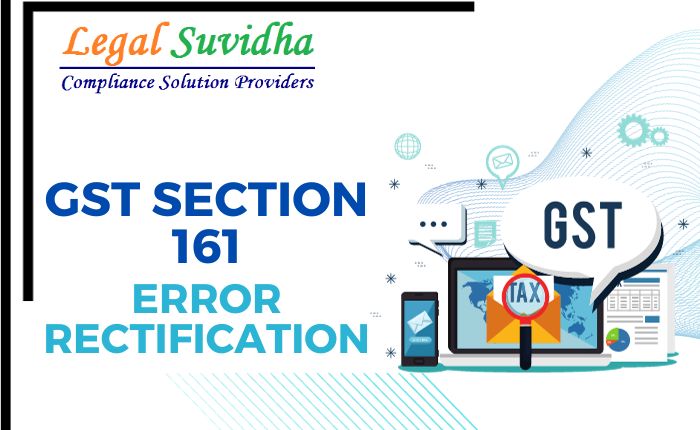The Goods and Services Tax (GST) in India was created in 2017 to make taxes simpler. But sometimes, mistakes happen, just like with anything complex. That’s where GST Section 161 comes into play. It helps correct mistakes in GST-related documents, like orders or notices. Let’s dive into what GST Section 161 is all about.
Understanding GST Section 161
GST Section 161 is a significant part of the CGST Act of 2017. It’s all about fixing errors or mistakes found in GST records. This section gives the authorities the power to correct these mistakes in documents like orders, notices, and certificates. Now, let’s break it down.
Who Can Make Corrections?
Corrections under Section 161 can happen in three ways:
1. On Their Own: Sometimes, authorities notice an error and fix it themselves without being asked.
2. When Notified: If someone sees a mistake in a document, they can ask the authority to correct it.
3. When GST Officials Notice: GST officials at the Central and State levels can also tell the authorities to fix mistakes.
What Are “Errors Evident on the Face of Records”?
This is a big part of Section 161. It’s about errors that are easy to see in a document. While the GST law doesn’t give a super exact definition, it includes three types of errors:
1. Legal Mistakes: These happen when the law is not followed or understood correctly. For example, if a decision doesn’t consider an important legal rule, it’s a legal mistake.
2. Factual Errors: These are about wrong facts in documents. If a document has incorrect information, it’s a factual error.
3. Small Mistakes: Simple errors, like math mistakes or typos, also count. These can usually be fixed easily.
If a mistake is clear from the document itself, it can be fixed under Section 161. But if it’s not so clear, it needs more evidence and can’t be fixed this way. For example, if an officer ignores documents taxpayer-provided, it’s a factual error that Section 161 can correct. Not following the right legal rules is a legal mistake that this section can also fix.
Learning from the Income Tax Act
To understand what counts as a “mistake” in legal terms, we can look at Section 154 of the Income Tax Act. It talks about different kinds of mistakes, like:
1. Misreading Clear Rules: When someone misunderstands or uses a rule incorrectly, it’s a mistake.
2. Using the Wrong Rule: Using a rule that doesn’t fit the situation is also a mistake.
3. Ignoring Important Rules: Sometimes, mistakes happen when important rules are ignored.
4. Using the Wrong Part of the Law: If someone uses the wrong part of the law, it’s a mistake.
5. Not Paying Attention to High Court Decisions: Ignoring decisions from the High Court can lead to mistakes too.
Time Limits for Fixing Mistakes
Fixing mistakes isn’t just for GST officials. Taxpayers can ask for corrections too. But there’s a time limit. Taxpayers need to start the process within three months from when the mistake was made. GST Section 161 also sets a time limit for making correction orders. It says that these orders must be made within six months from the date of the original document. However, this six-month rule doesn’t apply when fixing small, unintentional errors like typos.
In Conclusion
So, to sum it up, GST Section 161 is a way to fix mistakes in GST orders and decisions. It’s for errors that are easy to see in documents. If your request for a correction is denied, you can appeal under Section 107 of the CGST Act of 2017. Also, if correction is needed under Section 161 or if an order on the GST portal is withdrawn, the proper officer has to upload an abstract of the correction using Form GST DRC-08. This form includes details about the original document, the correction, and what happens after the correction.
If You have any queries then connect with us at [email protected] or [email protected] & Contact us & stay updated with our latest blogs & articles








